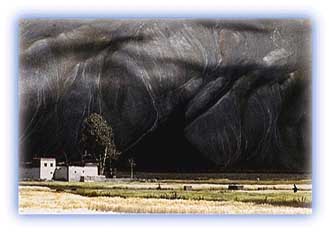Zanskar himalayas
General info
· Shingo La photo-feature
Approaching Zanskar from the Suru Valley
· Panikhar
· Penzella Pass
· Tangol
Zanskar Valley
· Shagma Karphu
· Karsha
Rivers
· Zanskar River
· Khurana River
People
· Rangdom Gompa
· Phuktal Gompa photo-feature

![]()
| Padam This is the largest town in the Zanskar Valley. It was once the capital of the Rajas of Zanskar. The area surrounding Padam is relatively flat. There is a level plain along the river which becomes water-logged in summer due to the melting of the snow. The soil is poor and thus crop yields are meagre. |
Trees have been planted in Padam for providing fuelwood and fodder, which are usually in short supply. They have to be brought in from outside as the surrounding mountain sides are devoid of vegetation, similar to Ladakh.
 |
| Cloud Shadows at Padam. A bare, steep mountain face of dark rock is mottled by the shadow of a passing cloud. Fields of barley grow quickly during the short summer Credit: Luke Powell |
The houses are made of stone and have been built according to traditional Ladakhi architecture.
The inhabitants of Padam are Buddhists and Muslims. This is one of the few settlements in Zanskar with a Muslim population. They are believed to be the descendants of men who came with Zorawar Singh from Kishtwar in his expedition to conquer Ladakh and Tibet. The victorious Zorawar Singh granted his followers land in Zanskar. The Muslim population of Padam is of Sunni faith. They speak both Kashmiri and the native language. Over the years Kashmiri has gradually fallen into disuse as the new generations are more proficient in the native tongue. These people were sharp witted and aggressive and hence dominated the meek and simple native population. They married local girls and converted them to Islam. Their population multiplied rapidly and though initially the Muslim followers of Zorawar Singh who settled in Zanskar could not have been more than a few dozen, they form a sizeable proportion of the population today.
Experts believe that due to their antagonistic behavior, the Muslims of Padam have still not been able to fully integrate into the local society.
There is a large gompa at Padam which is revered by the local Buddhist population and the inhabitants of surrounding villages.
Padam also has a school, a small dispensary and post and telegraph facilities. It is connected by road with Leh and Kargil, the latter being a summer route.
All rights reserved